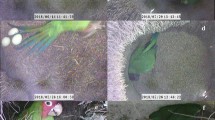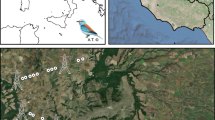Abstract
Although many parrot species are decreasing in their native range, introduced parrot populations can be found in urban areas around the globe. We thus need to understand how they adapt to this novel environment and to assess the possibility of a range expansion that might threaten native species. We studied population growth, nest site requirements, as well as limiting factors like reproductive output and mortality of the only European population of Yellow-headed Parrots (Amazona oratrix) in the city of Stuttgart, southwest Germany, to assess the risk of a possible range expansion. Although offspring could be seen on a regular basis, parrot numbers hardly increased during the last 5 years (51 individuals in spring 2015, including 12 breeding pairs). Ten accessible nest cavities were studied in detail: they were located exclusively in large, old London Plane (Platanus × acerifolia) trees in an area of less than 1 km2 in the city’s public parks and were at least 65 cm deep. Average reproductive output was 1.3 fledglings/pair, which is high in comparison to data from birds in their native range. Mortality, especially of young parrots, appears to be high due to risks in urban areas such as collisions with vehicles and windows and could partly explain slow population growth. This slow population growth in combination with the need for sufficiently large nest cavities may hinder a range expansion of this species in future years.
Zusammenfassung
Nisthöhlenmerkmale, Bruterfolg und Populations-entwicklung von eingebürgerten Gelbkopfamazonen in Deutschland Während viele Papageienarten in ihren heimischen Lebensräumen bedroht sind, werden sie weltweit in städtischen Lebensräumen häufiger, oft fernab von ihren ursprünglichen Vorkommen. Städte scheinen für das Überleben Vorteile zu bieten, zeigen jedoch auch die Anpassungsfähigkeit vieler Papageienarten an einen völlig neuen Lebensraum. Innerhalb Europas kommen Gelbkopfamazonen (Amazona oratrix) nur in Stuttgart vor. Um eine mögliche Ausbreitungstendenz bewerten zu können, untersuchten wir das Populationswachstum, Anforderungen an die Nisthöhlen, sowie den Reproduktionserfolg und die Mortalitätsraten dieser Art. Obwohl es an Nachwuchs nicht mangelte, nahm die Population in den letzten fünf Jahren kaum zu. Im Frühjahr 2015 wurden 51 Individuen gezählt, darunter 12 Brutpaare. Zehn Nester waren mit einem Hubsteiger erreichbar und wurden genau untersucht. Nisthöhlen waren ausschließlich in sehr alten, großen Platanen (Platanus × acerifolia) lokalisiert und konzentrierten sich auf einer Fläche von weniger als einem Quadratkilometer in den Parkanlagen der Stadt. Die Höhlen waren mindestens 65 cm tief. Der mittlere Reproduktionserfolg lag mit 1,3 Flügglingen pro Paar deutlich über dem aus dem Ursprungsland Mexiko bekannten Durchschnitt. Die Sterblichkeit vor allem junger Papageien war jedoch relativ hoch und könnte durch eine erhöhte Unfallgefahr in der Stadt erklärbar sein. Vor allem junge Amazonen kollidierten oft mit Autos oder prallten gegen Fensterscheiben. Dies scheint den derzeit geringen Populationsanstieg und die fehlende Ausbreitungstendenz zum Teil zu erklären. Zudem könnte der Mangel an ausreichend großen Nisthöhlen die Ausbreitung über die Stadtgrenzen hinweg erschweren.

Martens et al. (2013), modified

Similar content being viewed by others
References
Bauer HG, Berthold P (1996) Die Brutvögel Mitteleuropas. Bestand und Gefährdung. AULA, Wiesbaden
Bauer HG, Woog F (2008) Nichtheimische Vogelarten (Neozoen) in Deutschland. Teil I. Auftreten, Bestände und Status. Vogelwarte 46:157–194
Berkunsky I, Reboreda JC (2009) Nest site fidelity and cavity reoccupation by Blue-fronted Parrots Amazona aestiva in the dry Chaco of Argentinia. Ibis 151:145–150
Berkunsky I, Ruggera RA, Aramburú R, Reboreda JC (2012) Principales amenzas para la conservación del Loro Hablador (Amazona aestiva) en la región del impenetrabile, Argentinia. Hornero 27:39–49
BirdLife International (2015) Species factsheet: Amazona oratrix. http://www.birdlife.org. Accessed 30 Oct 2015
Brightsmith DJ (2005) Parrot nesting in south-eastern Peru: seasonal patterns and keystone trees. Wilson Bull 117:296–305
Bucher TL (1983) Parrot eggs, embryos, and nestlings: patterns and energetics of growth and development. Physiol Zool 56:465–483
Casagrande DG, Beissinger SR (1997) Evaluation of four methods for estimating parrot population size. Condor 99:445–457
Collar N (1997) Family Psittacidae (parrots). In: Del Hoyo J, Elliott A, Sargatal J (eds) Handbook of the birds of the world, vol 4. Lynx, Barcelona, pp 280–477 (Spainpen Access)
Czajka C, Braun MP, Wink M (2011) Resource use by non-native Ring-necked Parakeets (Psittacula krameri) and native Starlings (Sturnus vulgaris) in Central Europe. Open Ornithol J 4:17–22
DAISIE (2009) Handbook of alien species in Europe. Springer, Dordrecht
Eisermann K (2003) Status and conservation of Yellow-headed Parrot Amazona oratrix “guatemalensis” on the Atlantic coast of Guatemala. Bird Conserv Int 13:361–366
Enkerlin-Hoeflich EC (1995) Comparative ecology and reproductive biology of three species of Amazon Parrots in northeastern Mexico. Doctoral thesis. College StationA and M University, TX
Enkerlin-Hoeflich EC, Snyder NFR, Wiley JW (2006) Behaviour of wild Amazona and Rhynchopsitta parrots, with comparative insights from other psittacines. In: Luescher AU (ed) Manual of parrot behaviour, 1st edn. Blackwell, Ames, pp 13–25
Faegre S, Berkunsky I (2014) Post-fledging survival of Blue-fronted Parrots (Amazona aestiva). Ornitol Neotrop 25:55–61
Forshaw JM (1989) Parrots of the world, 3rd edn. Lansdowne, Melbourne
Garrett KL (1997) Conservation status and distribution of naturalized parrots in Southern California. West Birds 28:181–195
Groombridge B (ed) (1993) 1994 IUCN list of threatened animals. IUCN, Gland
Hernández-Brito D, Carrete M, Popa-Lisseanu AG, Ibáñez C, Tella JL (2014) Crowding in the city: losing and winning competitors of an invasive bird. PLoS One 9:e100593
Hölzinger J, Mahler U (2001) Die Vögel Baden-Württembergs 2.3: Nicht-Singvögel 3. Eugen Ulmer, Stuttgart
Hoppe D (1987) Amazonen, 3rd edn. Eugen Ulmer, Stuttgart
Hoppe D (1999) Exoten im park: die Gelbscheitelamazonen von Stuttgart. Falke 46:142–146
Hoppe D (2007) Sittiche und Papageien, 6th edn. Eugen Ulmer, Stuttgart
IUCN (2013) The IUCN Red List of threatened species. http://www.iucnredlist.org. Accessed August 2015
Juniper T, Parr M (1998) Parrots—a guide to the parrots of the world. Pica, East Sussex
König C, Mache R (2000) Die Wirbeltierfauna des Stuttgarter Rosensteinparks. Stutt Beiträge Naturkunde Serie C—Wissen für alle. Heft 46. Staatliches Museum für Naturkunde Stuttgart und Gesellschaft zur Förderung des Naturkundemuseums Stuttgart, Germany
Mabb KT (1997) Nesting behaviour of Amazona Parrots and Rose-ringed Parakeets in the San Gabriel Valley, California. West Birds 28:209–217
Mabb KT (2002) Naturalized (wild) parrots in California: a current assessment. Symposium Proceedings of the Gabriel Foundation Third Annual Symposium: Parrots in the New Millennium, 2002. 7–10 February, San Diego, CA
Magrath RD, Lill A (1985) Age-related differences in behaviour and ecology of Crimson Rosellas, Platycercus elegans, during the non-breeding season. Aust Wildl Res 12:299–306
Marín-Togo MC, Monterrubio-Rico TC, Renton K, Rubio-Rocha Y, Macías-Caballero C, Ortega-Rodríguez JM, Cancino-Murillo R (2012) Reduced current distribution of Psittacidae on the Mexican Pacific coast: potential impacts of habitat loss and capture for trade. Biodiver Conserv 21:451–473
Marsden SJ, Royle K (2015) Abundance and abundance change in the world’s parrots. Ibis 157:219–229
Martens J (2011) Neozoen im urbanen Raum—Amazonen in Stuttgart. B.Sc. thesis, Universität Hohenheim, Stuttgart
Martens J, Hoppe D, Woog F (2013) Diet and feeding behaviour of naturalised Amazon Parrots in Stuttgart, south-western Germany. Ardea 101:71–77
Martuscelli P (1995) Ecology and conservation of the Red-tailed Amazon Amazona brasiliensis in south-eastern Brazil. Bird Conserv Int 5:405–420
Masello JF, Quillfeldt P (2002) Chick growth and breeding success of the Burrowing Parrot. Condor 104:574–586
Menchetti M, Mori E (2014) Worldwide impact of alien parrots (Aves Psittaciformes) on native biodiversity and environment: a review. Ethol Ecol Evol 26:172–194
Monterrubio-Rico TC, Ortega-Rodríguez JM, Marín-Togo MC, Salinas-Melgoza A, Renton K (2009) Nesting habitat of the Lilac-crowned Parrot in a modified landscape in Mexico. Biotropica 41:361–368
Monterrubio-Rico TC, Renton K, Ortega-Rodríguez JM, Pérez-Arteaga A, Cancino-Murillo R (2010) The endangered Yellow-headed Parrot Amazona oratrix along the Pacific coast of Mexico. Oryx 44:602–609
Monterrubio-Rico TC, Álvarez-Jara M, Téllez-García L, Tena-Morelos C (2014) Hábitat de anidación de Amazona oratrix (Psittaciformes: Psittacidae) en el Pacífico Central, México. Rev Biol Trop 62:1053–1072
Ortiz-Catedral L, Hauber ME, Brunton DH (2013) Growth and survival of nestlings in a population of Red-crowned Parakeets (Cyanoramphus novaezelandiae) free of introduced mammalian nest predators on Tiritiri Matangi Island, New Zealand. N Z J Ecol 37:370–378
Prestes NP, Martinez J, Meyrer PA, Hansen LH, Xavier MN (1997) Nest characteristics of the Red-spectacled Amazon Amazona pretrei Temminck, 1830 (Aves, Psittacidae). Ararajuba 5:151–158
Renton K, Salinas-Melgoza A (1999) Nesting behaviour of the Lilac-crowned Parrot. Wilson Bull 111:488–493
Rivera L, Politi N, Bucher EH, Pidgeon A (2013) Nesting success and productivity of Tucuman Parrots (Amazona tucumana) in high-altitude forests of Argentina: do they differ from lowland Amazona Parrots? Emu 114:41–49
Rodríguez Castillo AM, Eberhard JR (2006) Reproductive behavior of the Yellow-crowned Parrot (Amazona ochrocephala) in Western Panama. Wilson J Ornithol 118:225–236
Salinas-Melgoza A, Renton K (2007) Postfledging survival and development of juvenile Lilac-crowned Parrots. J Wildl Manage 71:43–50
Salinas-Melgoza A, Salinas-Melgoza V, Renton K (2009) Factors influencing nest spacing of a secondary cavity-nesting parrot: habitat heterogeneity and proximity of conspecifics. Condor 111:305–313
Sebald O (1964) Die Bäume des Rosensteinparks in Stuttgart. Jahreshefte des Vereins für vaterländische Naturkunde in Württemberg 118/119, Stuttgart
Seixas GHF, Mourão GM (2002) Nesting success and hatching survival of the Blue-fronted Amazon (Amazona aestiva) in the Pantanal of Mato Grosso do Sul, Brazil. J Field Ornithol 73:399–409
Skeate S (1984) Courtship and reproductive behaviour of captive white-fronted Amazon Parrots Amazona albifrons. Bird Behav 5:103–109
Snyder NFR, Wiley JW, Kepler CB (1987) The parrots of Luquillo: natural history and conservation of the Puerto Rican Parrot. Western Foundation of Vertebrate Zoology, Los Angeles
Tella JL, Canale A, Carrete M, Petracci P, Zalba SM (2014) Anthropogenic nesting sites allow urban breeding in Burrowing Parrots Cyanoliseus patagonus. Ardeola 61:311–321
Acknowledgements
We are very grateful to Günther Schleussner, Micha Sonnenfroh and Clemens Hartmann from Wilhelma Zoo for cooperating with us. We thank Tomoko Arai and Dieter Hoppe for their help in observing the fledging process, during counts and for providing a lot of helpful information. We also thank Igor Berkunsky, Sophie Laidler, Klaus Martens, Raoul Ribot and anonymous reviewers for proofreading and editing the manuscript. All necessary permits were provided by the local authorities and the research complied with current German law.
Author information
Authors and Affiliations
Corresponding author
Additional information
Communicated by O. Krüger.
Rights and permissions
About this article
Cite this article
Martens, J.M., Woog, F. Nest cavity characteristics, reproductive output and population trend of naturalised Amazon parrots in Germany. J Ornithol 158, 823–832 (2017). https://doi.org/10.1007/s10336-017-1436-9
Received:
Revised:
Accepted:
Published:
Issue Date:
DOI: https://doi.org/10.1007/s10336-017-1436-9




